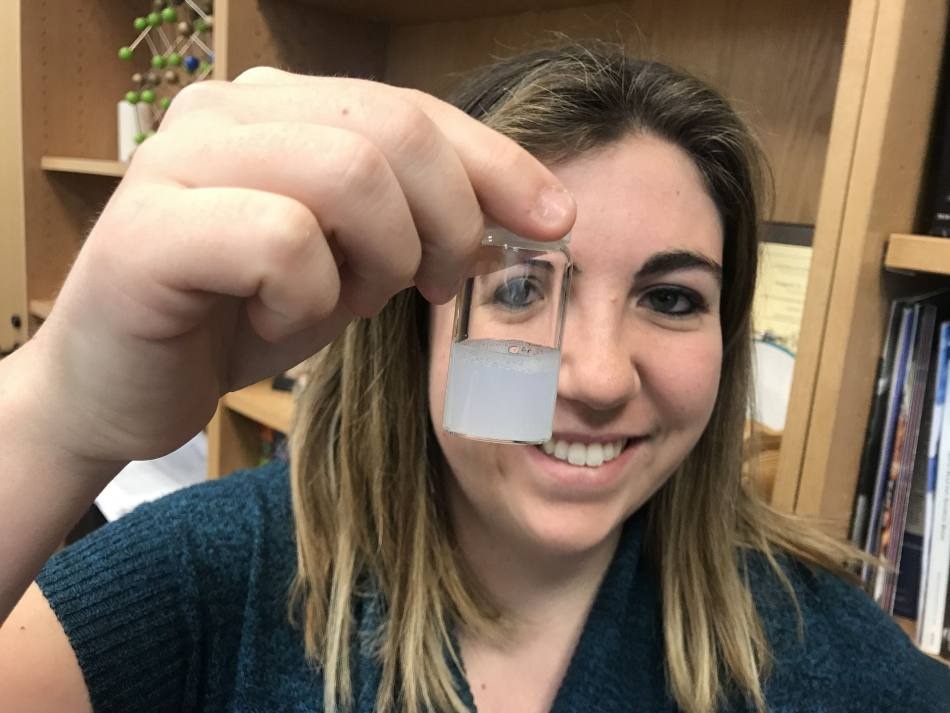Dec 21 2018
Boron nitride nanotubes truly like to stick together. They would remain stuck if they weren’t very useful. But since they are beneficial, Rice University chemists have established that surfactants—the standard compounds in soap—provide the best and easiest way to keep boron nitride nanotubes (BNNTs) from clumping. That could result in expanded use and in biomedical applications like delivering drugs to cells and in protective shields, as mechanical and thermal reinforcement for composite materials.
 Rice University graduate student Ashleigh Smith McWilliams holds a vial of boron nitride nanotubes in solution. McWilliams led a Rice effort to find the best way to separate the naturally clumping nanotubes to make them more useful for manufacturing. The nanotubes turn the clear liquid surfactant white when they are dispersed. (Image credit: Rice University)
Rice University graduate student Ashleigh Smith McWilliams holds a vial of boron nitride nanotubes in solution. McWilliams led a Rice effort to find the best way to separate the naturally clumping nanotubes to make them more useful for manufacturing. The nanotubes turn the clear liquid surfactant white when they are dispersed. (Image credit: Rice University)
The study led by Rice chemist Angel Martí was published this month in the Royal Society of Chemistry journal Nanoscale Advances.
BNNTs are like their well-known counterparts, carbon nanotubes, because both are hydrophobic—that is, they avoid water if at all possible. So in a solution, the nanotubes will search for each other and stick together to reduce their exposure to water.
But in contrast to carbon nanotubes, which can be either metallic conductors or semiconducting, BNNTs are pure insulators: Current will not pass.
They have super cool properties. They’re thermally and chemically stable and they’re a great fit for a bunch of different applications, but they’re inert and difficult to disperse in any solvent or solution. That makes it really difficult to make macroscopic materials out of them, which is what we would eventually like to do.
Ashleigh Smith McWilliams, Lead Author and Graduate Student, Rice University
Surfactants are amphiphilic molecules, with some parts attracted to water and other parts repelled by it. Since BNNTs are hydrophobic, they draw the similar part of the surfactant molecule, which wraps around the nanotube. The surfactant’s other half is hydrophilic and keeps the wrapped nanotubes detached and dispersed in solution.
Of the range of surfactants they checked out, cetyl trimethyl ammonium bromide (CTAB) was best at splitting BNNTs from each other totally, while Pluronic F108 put the most nanotubes— around 10% of the bulk—into solution.
Once separated, they can be transformed into fibers or films through processes like those put together by co-author Matteo Pasquali and his Rice lab, or mixed into composites to incorporate strength without increasing conductivity, McWilliams said. The surfactant itself can be washed or burned off when not needed anymore, she said.
A side advantage is that cationic surfactants like CTAB are mainly good at removing impurities like flakes of hexagonal boron-nitride (aka white graphene) from BNNTs. “That was a benefit we didn’t expect to see, but it will be useful for future applications,” McWilliams said.
“Boron nitride nanotubes are a great building block, but when you buy them, they come all clumped together,” Martí said. “You have to separate them before you can make something usable. This is what Ashleigh has achieved.”
He visualizes ultrathin coaxial cables with carbon nanotube fibers similar to those from Pasquali’s lab surrounded by BNNT shells, as well as capacitors of sandwiched carbon and BNNT films.
We’ve had metallic and semiconducting carbon nanotubes for a long time, but insulating BNNTs have been like the missing link. Now we can combine them to make some interesting electronics. It’s remarkable that a common surfactant found in everyday products like detergents and shampoo can also be used for advanced nanotechnology.
Angel Martí, Study Leader and Chemist, Rice University
The paper’s co-authors are Rice graduate student Carlos de los Reyes and undergraduate student Selin Ergülen; graduate student Lucy Liberman and Yeshayahu Talmon, professor emeritus of chemical engineering, at Technion—Israel Institute of Technology; and Pasquali, a Rice professor of chemical and biomolecular engineering, of materials science and nanoengineering and of chemistry. Martí is an associate professor of chemistry, of bioengineering and of materials science and nanoengineering.
The research was supported by the National Science Foundation, the Air Force Office of Scientific Research, the U.S.-Israel Binational Science Foundation, and the Welch Foundation.